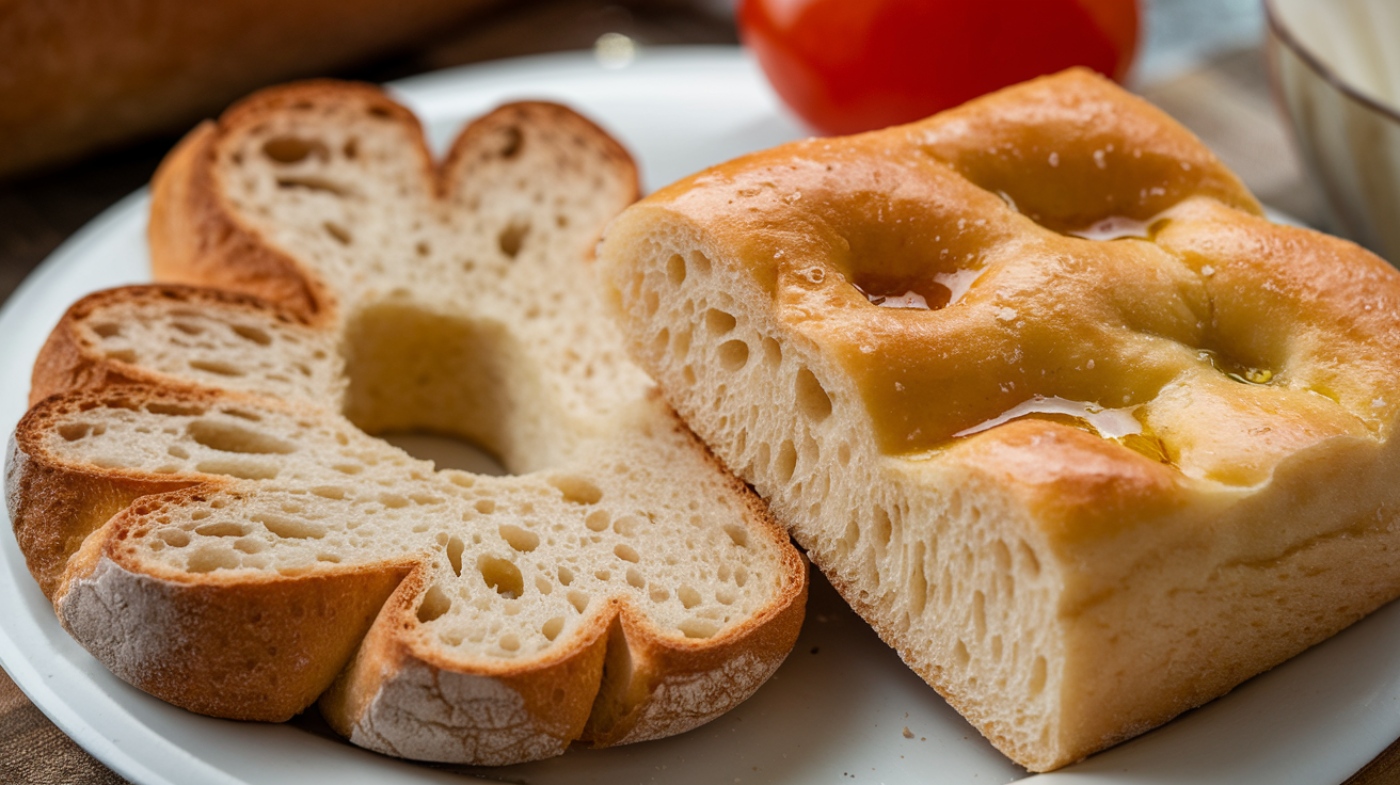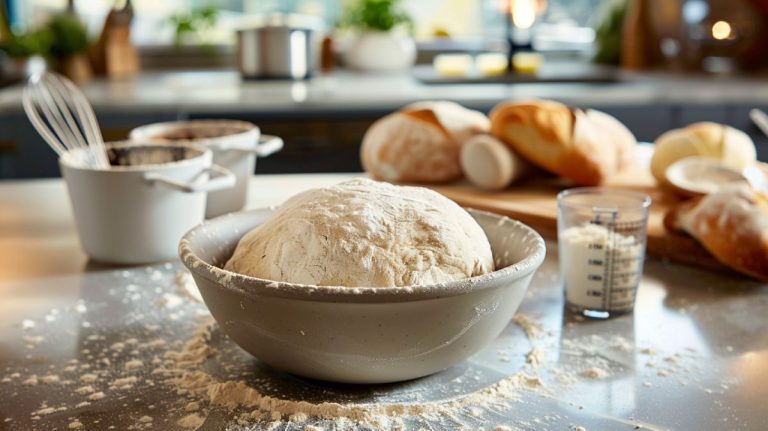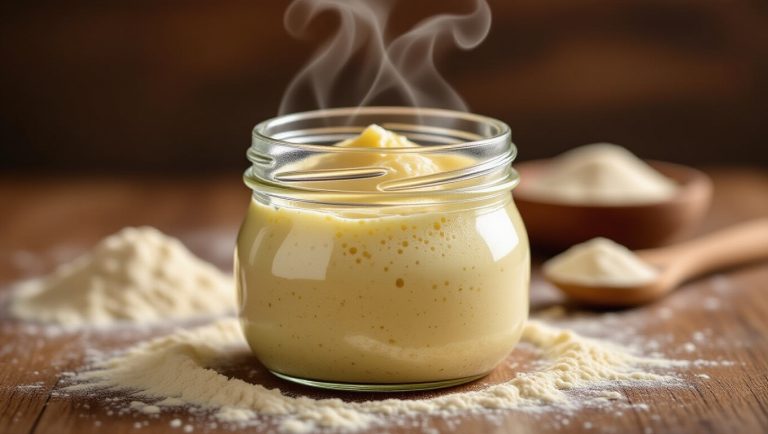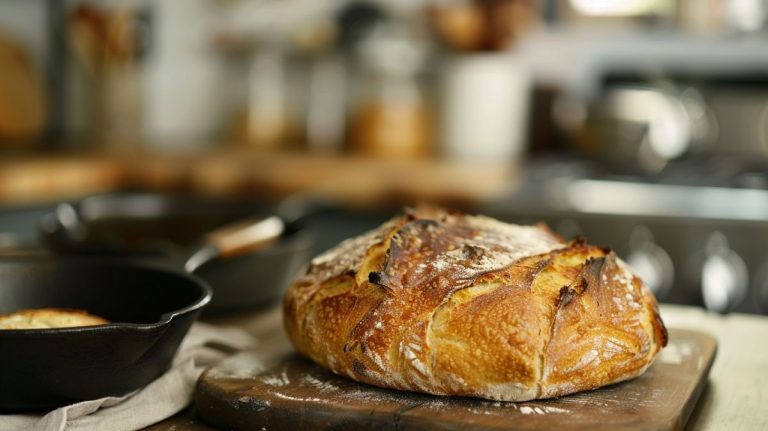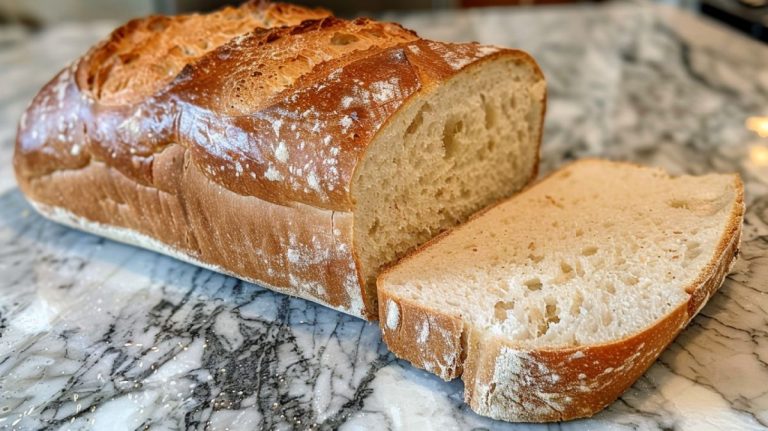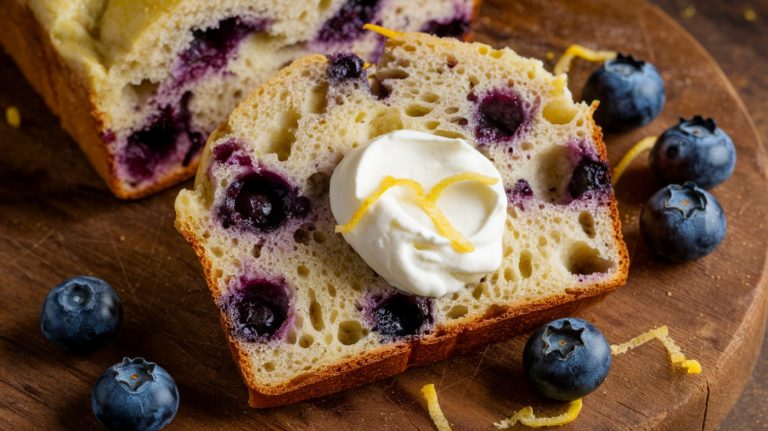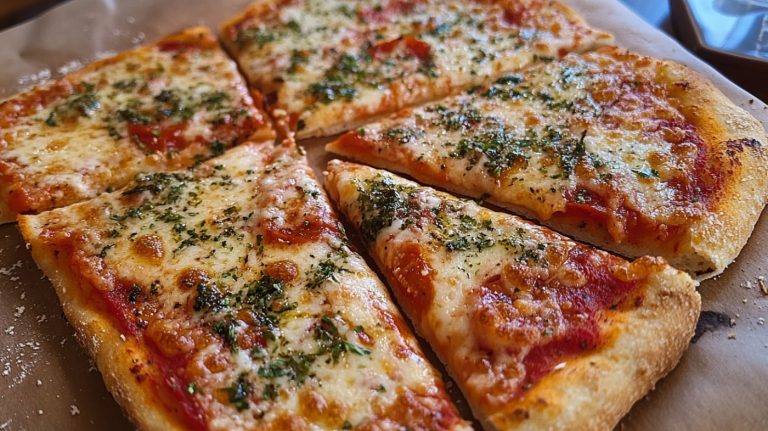Fougasse Vs Focaccia: A Flavorful Journey Through Two Iconic Breads
When you compare focaccia and fougasse, you’re exploring two delightful breads with distinct personalities. Focaccia, the Italian classic, is known for its fluffy texture, dimples, and aromatic toppings like rosemary and garlic.
It’s often baked in pans, giving it a soft, pillowy finish. On the other hand, fougasse hails from Provence and boasts a rustic charm, resembling a leaf with slashes that enhance its crispness.
This bread embraces hearty toppings, often featuring olives and herbs de Provence. Whether you fancy an Italian treat or a Provençal delight, both breads promise flavor and satisfaction. There’s much more to uncover about their unique characteristics.
Key Takeaways
- Focaccia is an Italian flatbread with a fluffy texture, while fougasse is a Provençal bread known for its rustic, leaf-like shape.
- Focaccia is baked in pans and features dimples to hold toppings, whereas fougasse is baked directly on hot stones with slashes for crispiness.
- Focaccia dough is enriched with olive oil, resulting in a softer bread, while fougasse uses a leaner dough for a chewier crust.
- Focaccia typically highlights Italian flavors like rosemary and garlic, while fougasse showcases Provençal ingredients such as olives and herbs de Provence.
- Both breads offer diverse topping options and can be served as appetizers or snacks, reflecting their cultural significance in Italian and Provençal cuisines.
Focaccia
Focaccia, a delightful Italian flatbread, combines the best crispy and fluffy textures in every bite. This bread is typically baked in sheet pans and can reach thicknesses of up to an inch. The magic starts with focaccia dough, which is leavened with yeast, giving it that airy interior. In fact, using a sourdough starter can enhance the flavor and create a unique texture, as seen in sourdough focaccia pizza. You’ll notice the signature dimples on the surface, which are perfect for holding olive oil and aromatic herbs.
Common toppings like rosemary, garlic, and thyme elevate the flavor profile, inviting you to experiment with various vegetables for added zest. The preparation isn’t overly complex; you can whip up this dish in just a couple of hours, including rising and baking time. Compared to traditional yeast breads, focaccia is relatively quick and rewarding.
Served warm, focaccia is perfect for dipping in high-quality olive oil or balsamic vinegar, making it a favorite starter or side dish in Italian meals.
Fougasse
When it comes to flatbreads, fougasse stands out with its unique leaf-like shape and crispy crust, offering a delightful alternative to focaccia. This traditional Provençal bread has roots dating back to ancient Rome, where it served as a snack and a method for testing oven temperatures. Over time, fougasse evolved into a beloved staple in Medieval Provence.
Fougasse is baked directly on a hot stone, which gives it that signature crunch you won’t find in focaccia, typically baked in a pan. You’ll often find it adorned with vibrant ingredients like olives, fragrant herbs de Provence, and even cheese, making it a flavorful addition to any meal. Its versatility shines as it’s commonly served as an appetizer or side dish, complementing soups, stews, or dips.
When you enjoy fougasse, you’re not just savoring a delicious bread; you’re also experiencing a piece of Provençal culture. The crispy texture, combined with its aromatic toppings, makes it a delightful choice for gatherings or a simple dinner at home.
Shape and Appearance Differences
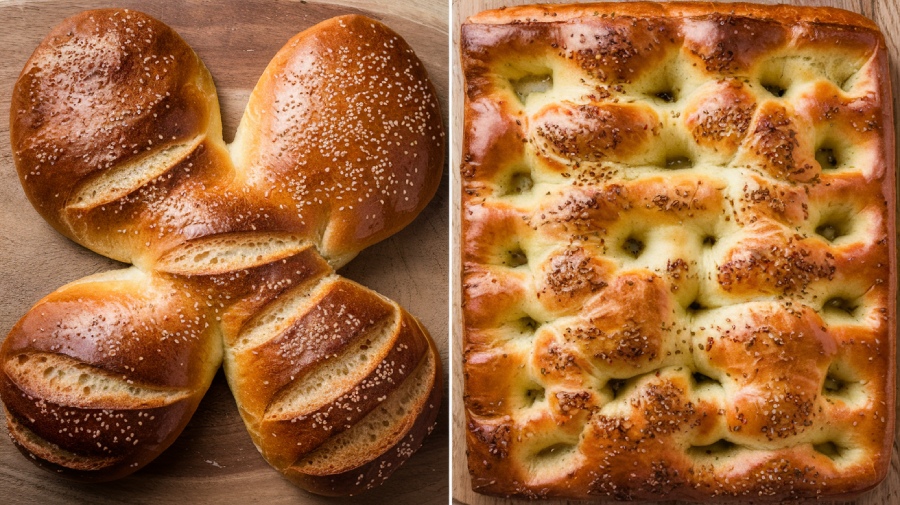
In the domain of flatbreads, the shape and appearance of fougasse and focaccia tell a story of their unique traditions. Focaccia typically bakes in rectangular sheet pans, resulting in a uniform thickness and a polished look. Its surface showcases dimples created during the rising process, which capture herbs and oil, giving it a smooth, even appearance.
On the other hand, fougasse is hand-shaped into oval forms, about 1/4 inch thick, presenting a rustic charm with irregular shapes and textures. The slashes or cuts on fougasse resemble leaves, enhancing its visual appeal and increasing surface area for crispiness while preventing cracking during baking. This design invites communal sharing, as the bread can be easily torn apart, unlike the structured slices of focaccia.
While focaccia boasts a sleek finish, the fougasse captivates with its unique, organic shapes. Both breads offer distinct visual experiences, but their shapes and appearances reflect their cultural roots and methods of preparation, making each a delightful addition to any meal.
Topping Variations
The distinct shapes of fougasse and focaccia not only highlight their cultural origins but also set the stage for their topping variations. Focaccia typically embraces Italian flavors, featuring toppings like rosemary, garlic, and an array of cheeses. You’ll find it can even transform into a pizza-style bread, letting you experiment with a multitude of toppings.
In contrast, fougasse reflects its Provençal roots with heartier toppings. It often showcases herbs de Provence and unique ingredients like olives, fennel, and anchovies. Slashes that cradle toppings enhance its visual appeal, making each piece a work of art.
Here are some popular topping variations to ponder:
- Rosemary and sea salt
- Olives and anchovies
- Garlic and cheddar cheese
- Fennel and tarragon
- Lavender and herbs de Provence
Both breads allow for additional toppings mixed into the dough, but they shine in different ways. While focaccia pairs wonderfully with olive oil or balsamic vinaigrette for dipping, fougasse’s versatility makes it a great companion for various dips and spreads, enriching your culinary experience.
Dough Preparation Techniques
When you prepare the dough for fougasse and focaccia, you’ll notice some key ingredient differences right away. Focaccia’s inclusion of olive oil gives it rich moisture that fougasse, often made with a leaner baguette dough, lacks. Additionally, the rising methods for each bread vary, with focaccia taking its time to develop that fluffy texture, while fougasse is shaped and slashed after just one rise.
Ingredient Differences Explained
Fougasse and focaccia may seem similar at first glance, but their dough preparation techniques reveal distinct differences that affect their final texture and flavor. While both breads share ingredients like flour, water, yeast, and salt, the amounts and methods used set them apart. For instance, fougasse typically contains less oil, leading to a denser texture, whereas focaccia’s richness comes from the generous use of olive oil.
Here are some key differences in their dough preparation:
- Fougasse dough is shaped and flattened by hand, giving it a rustic feel.
- Focaccia is usually rolled or stretched in a pan, leading to varied thicknesses.
- Traditional fougasse may use baguette dough, resulting in a chewier crust.
- Fougasse features scoring techniques that create unique openings, enhancing texture.
- Focaccia is known for dimples that help retain oil and herbs.
Rising Methods Compared
In bread baking, rising methods play an essential role in determining texture and flavor, showcasing the unique characteristics of both fougasse and focaccia. When you make focaccia, it typically rises in the baking pan, resulting in a thicker, airier interior. This method allows the dough to capture the flavors of olive oil and herbs during the dimpling process, creating that signature taste. In contrast, fougasse rises on flat surfaces, contributing to its denser texture and unique leaf-like shape.
While both breads require similar total preparation times—around two hours—focaccia generally undergoes a single rise in the pan, whereas fougasse experiences a two-step rise: first as a whole dough ball and then after shaping. The slashing techniques used in fougasse are essential; they not only enhance crispiness but also define its striking appearance.
Both share flour, water, yeast, and oil in terms of ingredients, but fougasse may use baguette dough that lacks oil, affecting its final texture.
Baking Methods Compared
When it comes to baking fougasse and focaccia, the surface you choose makes a big difference in the final product. Baking fougasse on a hot stone gives it that irresistible crispy texture, while focaccia’s sheet pan method results in a softer, thicker loaf. Plus, the handling techniques for each dough play an essential role in shaping their unique characteristics, from the slashed patterns of fougasse to the dimples of focaccia.
Baking Surface Differences
Baking on a hot stone transforms fougasse into a culinary masterpiece, creating a crispy texture and a robust crust that sets it apart from focaccia. While focaccia typically rises in a baking sheet or tray, resulting in a thicker, softer crust, fougasse is flattened by hand, allowing for a more varied and intriguing texture.
Here are some key differences in baking surfaces:
- Heat Distribution: A hot stone provides even heat, enhancing the crusty exterior of fougasse.
- Texture Variation: Fougasse’s hand-flattened shape leads to unique textures, unlike the uniformity of focaccia.
- Scoring Technique: The characteristic leaf-like cuts in fougasse help steam escape, preventing sogginess.
- Baking Temperature: Fougasse is baked at higher temperatures (400°F to 425°F) for that desired crunch, while focaccia is usually at 375°F to 400°F.
- Baking Sheet Use: Focaccia’s reliance on a baking sheet promotes a softer finish, contrasting sharply with fougasse’s crispy bite.
Dough Handling Techniques
The way you handle the dough for fougasse and focaccia plays a considerable role in their final textures and flavors. For fougasse, you’ll want to shape the dough by hand into oval forms, allowing it to develop a rustic character. The slashing technique, where you make cuts before baking, not only gives it that distinctive leaf-like appearance but also enhances its crispiness. In contrast, focaccia is pressed into rectangular sheet pans, creating a fluffy interior and a softer bottom.
When it comes to dough handling techniques, remember that fougasse requires a delicate touch during shaping and slashing to maintain its structure. The dough typically contains less oil than focaccia, resulting in a different mouthfeel. Focaccia’s richer, oilier dough contributes to its airy texture, so be generous when brushing oil over its surface before baking.
Both breads demand adequate rising time, but the handling methods diverge considerably.
Flavor Profiles and Ingredients
Exploring fougasse and focaccia’s flavor profiles and ingredients reveals distinct culinary identities that reflect their regional origins. Fougasse bursts with the vibrant flavors of herbs de Provence—think fennel, mint, and lavender. You might even find heartier toppings like anchovies or cheese, adding depth to each bite. On the other hand, focaccia leans towards simplicity, with rosemary and thyme often taking center stage, complemented by lighter toppings like garlic and sliced tomatoes.
Here are some key differences in their flavor profiles:
- Fougasse often includes diverse toppings like sun-dried tomatoes and lardons.
- Focaccia typically features olive oil, enriching the dough and enhancing its natural flavor.
- You might encounter sweet variations of fougasse, incorporating honey or dried fruits.
- Fougasse can use baguette dough, which lacks oil, giving it a unique texture.
- Focaccia, with its olive oil-rich dough, is known for its soft and fluffy interior.
Cultural Significance
Cultural significance weaves through the stories of fougasse and focaccia, showcasing how these breads reflect their regions’ traditions and communal values. Originating from Provence, France, fougasse embodies the essence of regional culinary traditions. It’s often served during social gatherings, reinforcing the Provençal culture of communal meals. The use of local ingredients, like herbs de Provence and olives, highlights the area’s agricultural heritage and fosters connection among diners.
On the other hand, focaccia, with its historical roots in ancient Roman bread-making, illustrates Italy’s culinary creativity. This versatile bread adapts to various toppings and flavors, allowing each region to showcase its unique ingredients. Focaccia often appears as a shared snack or an accompaniment to meals, enhancing the communal atmosphere of Italian dining.
Both breads serve as symbols of their respective cultures, reflecting adaptability and the importance of togetherness. Whether enjoying fougasse as an appetizer or savoring focaccia during a family feast, each bite connects you to the rich tapestry of communal meals and regional traditions that define these beloved breads.
Popular Serving Suggestions
When you think about serving fougasse and focaccia, a world of delightful possibilities opens up. These two breads, rooted in French and Italian traditions, can elevate any meal with their unique textures and flavors.
Consider these popular serving suggestions:
- Warm with Dips: Serve fougasse warm, paired with olive oil or tapenade for a mouthwatering appetizer.
- Snack Time: Enjoy focaccia as a standalone snack, drizzled with balsamic vinegar or topped with your favorite cheese and cured meats.
- Soup Companion: Pair fougasse with hearty soups, where its crispy texture enhances the brothy goodness.
- Salad Addition: Add focaccia to salads for a fluffy element that balances freshness and flavor.
- Wine Pairing: Both breads shine with structured, dry rosé wines, perfect for casual gatherings or festive Mediterranean dinners.
Exploring Recipe Variations
The possibilities for flavorful ingredient combinations are endless when you think about making fougasse or focaccia. You can draw inspiration from regional variations, incorporating local favorites like olives or sun-dried tomatoes for a unique twist. For instance, consider experimenting with seasonal ingredients like butternut squash, which adds a sweet and savory flavor to your bread, as seen in focaccia with butternut squash. Experimenting with different toppings and fillings enhances the taste and allows you to showcase your creativity in the kitchen.
Flavorful Ingredient Combinations
Exploring the vibrant world of flavorful ingredient combinations, you’ll quickly discover that fougasse and focaccia offer delightful kitchen creative opportunities. Both breads boast unique characteristics, with focaccia featuring a chewy crust and airy texture that sun-dried tomatoes can enhance for added depth.
While both are delicious flatbreads, their flavor profiles can diverge dramatically based on your chosen ingredients. Fougasse, with its regional flair, often incorporates ingredients like olives, herbs de Provence, and rich cheeses. You can enhance its savory profile with sautéed vegetables such as peppers and onions or even plunge into sweet variations with honey or fruits.
Conversely, Focaccia typically showcases simple yet satisfying toppings like rosemary, garlic, and tomatoes. Here are some exciting combinations you might want to try:
- Olives and feta for a Mediterranean twist
- Sautéed mushrooms and thyme for an earthy flavor
- Sun-dried tomatoes and basil for a burst of freshness
- Caramelized onions and bacon for a savory indulgence
- Fig and goat cheese for a sweet and tangy delight
Regional Variation Inspirations
Regional variations in fougasse and focaccia reveal how local ingredients and culinary traditions shape these beloved breads. In southern France, fougasse often incorporates Provençal staples like olives, herbs de Provence, and rich cheeses, giving you a taste of the region’s vibrant flavors. You might even encounter sweet versions adorned with honey and nuts, showcasing the bread’s versatility at different occasions.
On the flip side, focaccia, or panis focacius, thrives on Italian flavor profiles, frequently featuring aromatic rosemary, pungent garlic, and a variety of cheeses as toppings. This bread invites creativity, allowing you to sprinkle seasonal vegetables or drizzle balsamic reductions for an extra punch.
Both breads encourage experimentation; you can enhance fougasse with sun-dried tomatoes or anchovies, while focaccia can take on a myriad of flavors that reflect local harvests. The unique shaping techniques—like the leaf-like slashes in fougasse and the characteristic dimples in focaccia—create visual appeal and enhance the baking process and flavor retention.
Frequently Asked Questions
Why Is It Called Fougasse?
It’s called fougasse because the name derives from the Latin “focus,” meaning “hearth.” This reflects its ancient roots in baking flatbreads, showcasing regional flavors and decorative styles that highlight its Provençal culinary heritage.
What Does Fougasse Taste Like?
Fougasse tantalizes your taste buds with its savory, aromatic flavors from herbs and olives. Its crispy crust and chewy interior offer a delightful texture, while olive oil adds richness, making it perfect for pairing or enjoying alone.
What Is a Fougasse in Italian?
Fougasse, in Italian, refers to a flatbread known for its unique leaf-like cuts and crispy texture. It’s often enjoyed with olive oil and herbs, making it a delightful addition to any meal or gathering.
How to Eat Fougasse?
To eat fougasse, you’ll want to tear off pieces, dip in olive oil or vinegar, savor its flavors, share with friends, and enjoy warm alongside soups or stews for a delightful experience.
Bread Showdown: The Fluffy Focaccia vs. the Rustic Fougasse
In the epic showdown of focaccia versus fougasse, you’ve discovered that these two heavenly breads are more than just dough—they’re culinary masterpieces! From their divine shapes to tantalizing toppings, each bite transports you straight to the sun-kissed hills of Italy.
Whether you’re savoring the soft, pillowy focaccia or the artful, leaf-like fougasse, you’re indulging in a symphony of flavors that’ll make your taste buds dance like nobody’s watching. So, go ahead—embrace the bread revolution.

